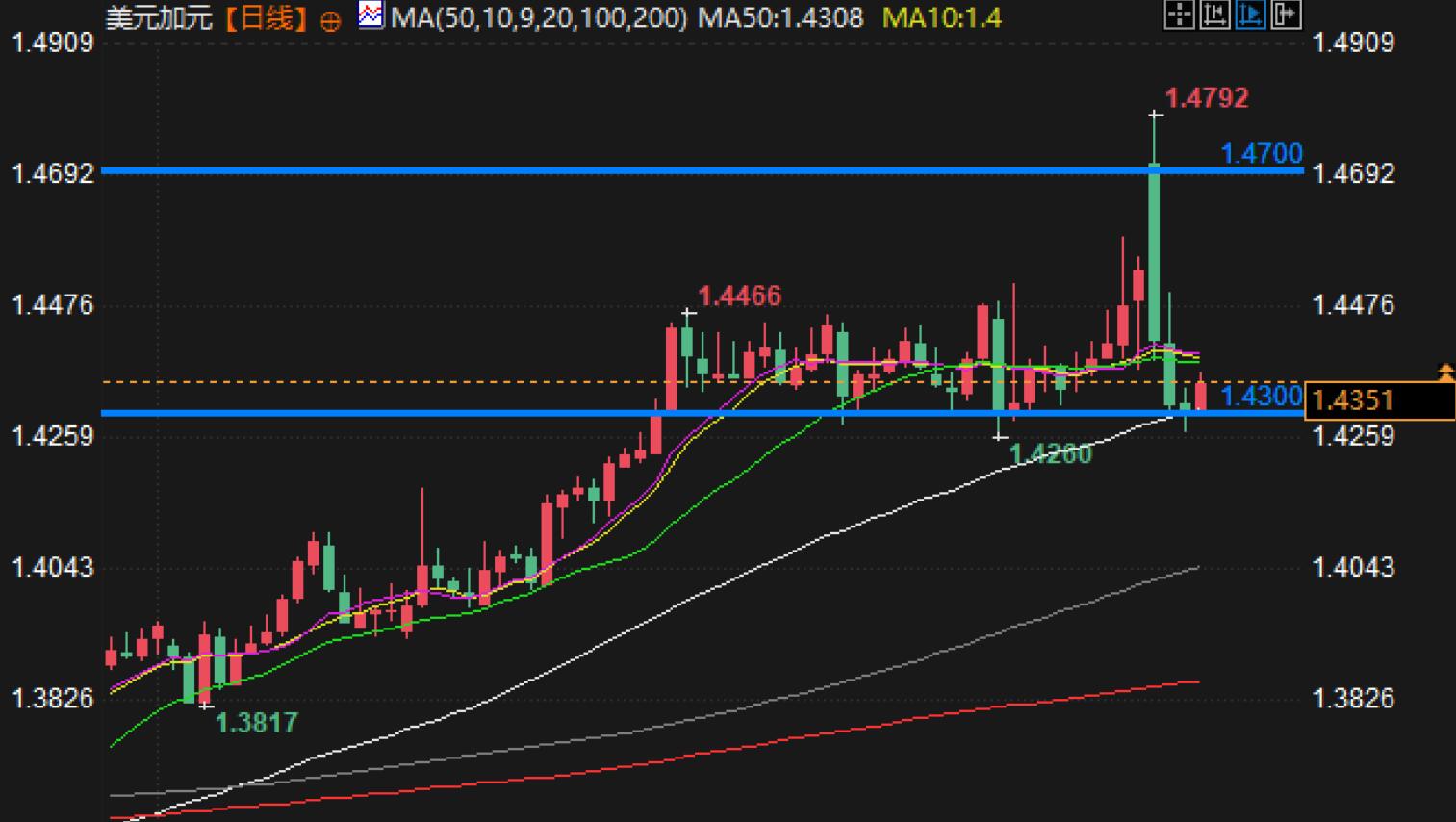Forex Trading Analysis: Expectations of US Canada Spread Expanding, How Will the Market Go?
The Canadian dollar has recently rebounded from its weakest level since 2003, but the sustainability of this rebound has raised doubts among some analysts. We still have doubts about the sustainability of the recent rebound in the Canadian dollar, "said John Velis, a strategist at Bank of New York
This observation is based on Monday (February 3) when the US dollar/Canadian dollar exchange rate briefly rose to 1.4793, triggering fluctuations in other non US dollar/Canadian dollar exchange rates. Despite the rebound of the Canadian dollar, some analysts believe that the economic environment in Canada remains uncertain due to the impact of tariff policies, which may suppress further appreciation of the Canadian dollar.
Willis believes that Canada is currently in a "floating state" of tariffs, which has a negative impact on market sentiment. Willis explained, "The volatility of the Canadian dollar is extremely high, and since the beginning of the year, the return to volatility ratio of the Canadian dollar has ranked fifth from the bottom among the more than 30 major currencies we have tracked. Although the Canadian dollar is not a strong interest rate yielding currency, the risk return of trading the Canadian dollar has been very unattractive since January 1st
Nevertheless, the Canadian dollar rebounded from Monday's intense selling, with the US dollar/Canadian dollar exchange rate falling to 1.4346, the pound/Canadian dollar (GBP/CAD) falling to 1.79, and the euro/Canadian dollar (EUR/CAD) falling to 1.49. This rebound was mainly driven by the news that the trade tariffs between the United States and Canada were avoided at the last minute. Trump and Trudeau have reached an agreement to suspend the implementation of tariffs that came into effect this week, so that negotiators can negotiate a new trade agreement. Further feedback is expected to be provided in early March.
Despite the short-term rebound of the Canadian dollar, the Bank of New York believes that there may be an inconsistency in the relationship between the Canadian dollar and two-year bond yields. The research conducted by the bank indicates a significant correlation between the US dollar/Canadian dollar exchange rate and the two-year bond yields of the United States and Canada. We believe that this correlation will resurface soon, as the two-year bond yields reflect relative monetary policy expectations. Due to Canada's macroeconomic fundamentals being different from those of the United States, the Bank of Canada is likely to adopt more aggressive policies in terms of interest rates, "warned Willis
From this perspective, even if trade relations gradually return to normal, the weakness of the Canadian dollar may continue.
Goldman Sachs analysts previously estimated that if the Canadian dollar exchange rate changes in a typical reaction to changes in trade terms, it could depreciate by about 13%, and overall tariffs could reach 25%. Although the initial tariffs on energy products are relatively low (energy products account for a quarter of Canada's exports to the United States), slightly lowering this estimate, Goldman Sachs still believes that this forecast is a reasonable theoretical endpoint considering the changing uncertainties.
Technical analyst interpretation:
From a technical perspective, the recent volatility of the Canadian dollar has strong key technical signals, especially in the trend of USD/CAD, where technical indicators show possible short-term pressure and support points. The US dollar/Canadian dollar broke through 1.4793 on Monday and hit a new high before falling back to 1.4346, indicating the current high volatility of the market and sensitivity to changes in trade policies.
Technically, the 1.47 region remains a key technical resistance level. If the US dollar/Canadian dollar breaks through this resistance level, it may accelerate its rise and further challenge the 1.50 region. However, if the exchange rate cannot break through 1.47, it may lead to a short-term correction, and the 1.43 area will become the support level. The fluctuation of the US dollar/Canadian dollar within the recent range indicates the market's cautious attitude towards future uncertainty.

In addition, recent fluctuations in bond yields may also affect the trend of the Canadian dollar. The spread between the US dollar and the Canadian dollar is a key technical factor, and if the spread between the US and Canada continues to widen, the US dollar/Canadian dollar may further rise. The market currently expects the Bank of Canada to take more aggressive measures in interest rate policy, while the US monetary policy may remain relatively loose.
In the short term, the technical trend of USD/CAD is still influenced by trader sentiment. If the current trade situation is eased, the Canadian dollar may temporarily strengthen, but once trade uncertainty re intensifies, the technical outlook may once again point to a breakthrough in the 1.47 or even 1.50 region.
summary
Overall, the outlook for the Canadian dollar remains uncertain in both fundamental and technical aspects. Although the Canadian dollar has rebounded in the short term due to the avoidance of tariff policies, the trade situation remains a potential risk factor. Technically speaking, the fluctuation range of the US dollar/Canadian dollar has not yet been clearly broken through, and the market will closely monitor the impact of future trade negotiations and interest rate differentials on the trend of the Canadian dollar. In the current market environment, the short-term trend of the Canadian dollar may still be strongly driven by changes in the global economic and trade situation.
Tips:This page came from Internet, which is not standing for FXCUE opinions of this website.
Statement:Contact us if the content violates the law or your rights
